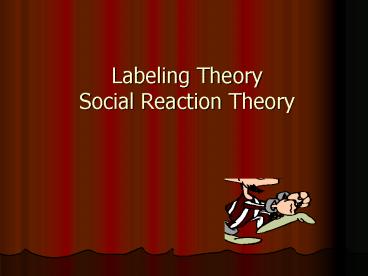Labeling Theory Social Reaction Theory - PowerPoint PPT Presentation
1 / 11
Title:
Labeling Theory Social Reaction Theory
Description:
Kid throws a stone at neighbor's car. Informal social reaction: ... Kid sees self as 'delinquent' Kid robs a local grocery store with members of a gang ... – PowerPoint PPT presentation
Number of Views:1093
Avg rating:3.0/5.0
Title: Labeling Theory Social Reaction Theory
1
Labeling TheorySocial Reaction Theory
2
Edwin M. Lemert
- Primary Deviance occasional or situational
behavior that may be excused or rationalized by
the actor and/or the social audience (i.e., rule
breaking). - Secondary Deviance result of a dynamic
interaction between the individuals deviation
and the societal response.
3
Relationship between Primary Deviation
Secondary Deviation
- PD ? no social reaction ? No SD
- PD ? mild social reaction ? No SD
- PD ? strong/public reaction ? SD
- PD X? SD
4
Labeling Process
- Kid throws a stone at neighbors car
- Informal social reaction neighbor gets angry
- Kid lets neighbors dog out
- Increased social reaction neighbor tells the
parents
5
Labeling Process continued
- Kid is caught shoplifting
- Formal reaction adjudicated juvenile
delinquent - Kid sees self as delinquent
- Kid robs a local grocery store with members of a
gang
6
Howard S. Becker
- Labeling theorist
- ethnographer
- jazz musician
- Author of Outsiders
- (1963)
7
Labeling
- Moral Entrepreneurs Individuals who either serve
as rule creators or rule enforcers. - Moral Crusader Individuals who believe that
their moral values are superior to those of
others.
8
Labeling Theory Contributions
- Deviance as a result of the social process.
- Deviants achieve status by social definition, not
inborn traits. - Reaction of society is the major element in
determining criminality. - Negative self-images follow formal mechanisms.
- Labeling perpetuates crime.
9
Evaluation
- Assigns a passive role to the offender
- Once a deviant always a deviant
- Too much emphasis on the system
10
Crime, Shame, ReintegrationJohn Braithwaite
- Societies have lower crime rates if they
effectively communicate shame about crime.
Violent behavior increases if the behavior isnt
shameful.
11
Crime, Shame, ReintegrationJohn Braithwaite
- Disintegrative shaming when offenders are
treated like outcasts and no attempt is made to
forgive them. - Reintegrative shaming Efforts are made to bring
the offender back into the community. Reduces
continued deviance when offenders feel ashamed.































